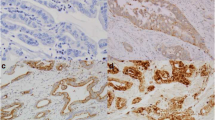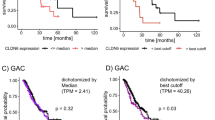Abstract
Claudins (CLDNs) are key molecules in cell adhesion, polarity, and control of paracellular solute transport. Several studies suggested that changes in claudin pattern have a role in cancer development. This study aimed to detect alterations in CLDN 1, 2, 3, 4, and 7 expression patterns in Barrett's esophagus (BE) and adenocarcinoma (ACC) compared with that in foveolar epithelium (FOV), normal squamous epithelium (SQ), and squamous cell carcinoma (SQCC). One hundred twenty five surgically or endoscopically removed, paraffin-embedded cases were studied by immunohistochemistry and analyzed statistically. BE, ACC, and FOV were dissected from 30 paraffin-embedded samples for further mRNA expression analysis. CLDN 7 was the dominating type in all epithelia and carcinomas, but its expression did not differ in normal and altered tissues. CLDN 1 expression was significantly increased in SQCC compared with that in SQ. CLDNs 3 and 4 were significantly elevated both in BE and ACC compared with that in FOV. CLDN 2 expression increased significantly in ACCs compared with that in BE. This is the first report proving similarities and differences regarding claudin expression pattern in BE and ACC compared with that in FOV and SQ. Our data prove a close link in CLDN pattern between BE and ACC, adding further evidence that BE is an alteration preceding esophageal ACC.





Similar content being viewed by others
References
Amasheh S, Meiri N, Gitter AH, Schoneberg T, Mankertz J, Schulzke JD, Fromm M (2002) Claudin-2 expression induces cation-selective channels in tight junctions of epithelial cells. J Cell Sci 115:4969–4976
Bailey T, Biddlestone L, Shepher N, Barr H, Warner P, Jankowski J (1998) Altered cadherin and catenin complexes in the Barrett's esophagus–dysplasia–adenocarcinoma sequence. Correlation with disease progression and dedifferentiation. Am J Pathol 152:135–144
Blot WJ, Devesa SS, Kneller RW, Fraumeni JF Jr (1991) Rising incidence of adeno-carcinoma of the esophagus and gastric cardia. JAMA 265:1287–1289
Bottger TC, Youssef V, Dutkowski P, Maschek H, Brenner W, Junginger T (1998) Expression of CD44 variant proteins in adenocarcinoma of Barrett's esophagus and its relation to prognosis. Cancer 83:1074–1080
Cameron AJ (2002) Epidemiology of Barrett's esophagus and adenocarcinoma. Dis Esophagus 15:106–108
Escaffit F, Boudreau F, Beaulieu JF (2005) Differential expression of claudin-2 along the human intestine: implication of GATA-4 in the maintenance of claudin-2 in differentiating cells. J Cell Physiol 203:15–26
Furuse M, Sasaki H, Tsukita S (1999) Manner of interaction of heterogeneous claudin species within and between tight junction strands. J Cell Biol 147:891–903
Furuse M, Furuse K, Sasaki H, Tsukita S (2001) Conversion of zonulae occludentes from tight to leaky strand type by introducing claudin-2 into Madin-Darby canine kidney I cells. J Cell Biol 153:263–272
Hamelin R, Flejou JF, Muzeau F, Potet F, Laurent-Puig P, Fekete F, Thomas G (1994) TP53 gene mutations and p53 protein immunoreactivity in malignant and premalignant Barrett's esophagus. Gastroenterology 107:1012–1018
Hamilton SR, Smith RR (1987) The relationship between columnar epithelial dysplasia and invasive adenocarcinoma arising in Barrett's esophagus. Am J Clin Pathol 87:301–312
Heinzelmann-Schwarz VA, Gardiner-Garden M, Henshall SM, Scurry J, Scolyer RA, Davies MJ (2004) Overexpression of the cell adhesion molecules DDR1, Claudin 3, and Ep-CAM in metaplastic ovarian epithelium and ovarian cancer. Clin Cancer Res 10:4427–4436
Hirohashi S, Kanal Y (2003) Cell adhesion system and human cancer morphogenesis. Cancer Sci 94:575–581
Hourihan RN, O'Sullivan GC, Morgan JG (2003) Transcriptional gene expression profiles of oesophageal adenocarcinoma and normal oesophageal tissues. Anticancer Res 23:161–165
Katahira J, Inoue N, Horiguchi Y, Matsuda M, Sugimoto N (1997) Molecular cloning and functional characterization of the receptor for Clostridium perfringens enterotoxin. J Cell Biol 136:1239–1247
Kimura Y, Shiozaki H, Hirao M, Maeno Y, Doki Y, Inoue M, Monden T Ando-Akatsuka Y, Furuse M, Tsukita S, Monden M (1997) Expression of occludin, tight-junction-associated protein, in human digestive tract. Am J Pathol 151:45–54
Kominsky SL, Argani P, Korz D, Evron E, Raman V, Garrett E, Rein A, Sauter G, Kallioniemi O-P, Sukumar S (2003) Loss of the tight junction protein claudin-7 correlates with histological grade in both ductal carcinoma in situ and invasive ductal carcinoma of the breast. Oncogene 22:2021–2033
Krishnadath KK, Tilanus HW, van Blankenstein M, Hop WCJ, Kremers ED, Dinjens WNM, Bosman FT (1997) Reduced expression of the cadherin–catenin complex in oesophageal adenocarcinoma correlates with poor prognosis. J Pathol 182:331–338
Lagorce-Pagès C, Paraf F, Wendum D, Martin A, Fléjou J-F (2004) Expression of inflammatory secretory phospholipase A2 and cytosolic phospholipase A2 in premalignant and malignant Barrett's oesophagus. Virchows Arch 444:426–435
Langbein L, Grund C, Kuhn C, Praetzel S, Kartenbeck J, Brandner JM, Moll I, Franke WW (2002) Tight junctions and compositionally related junctional structures in mammalian stratified epithelia and cell cultures derived therefrom. Eur J Cell Biol 81:419–435
Lódi C, Kiss A, Holczbauer Á, Batmunkh E, Paku S, Illyés G, Kupcsulik P, Schaff Z (2004) High expression of claudin 4 in human cholangiocellular carcinomas. Gastroenterology Week Freiburg 2004: Gastroenterology yesterday–today–tomorrow: a review and preview. FALK symposium no. 144, Freiburg, Germany, October 16–17
Long H, Crean CD, Lee WH, Cummings OW, Gabig TG (2001) Expression of Clostridium perfringens enterotoxin receptors claudin-3 and claudin-4 in prostate cancer epithelium. Cancer Res 61:7878–7881
Matsuda M, Kubo A, Furuse M, Tsukita S (2004) A peculiar internalization of claudins, tight junction-specific adhesion molecules, during the intercellular movement of epithelial cells. J Cell Sci 117:1247–1257
Michl P, Buchholz M, Rolke M, Kunsch S, Lohr M, McClane B, Tsukita S, Leder G, Adler G, Gress TM (2001) Claudin-4: a new target for pancreatic cancer treatment using Clostridium perfringens enterotoxin. Gastroenterology 121:678–684
Miwa N, Furuse M, Tsukita S, Niikawa N, Nakamura Y, Furukawa Y (2001) Involvement of claudin-1 in the β-catenin/Tcf signaling pathway and its frequent upregulation in human colorectal cancers. Oncol Res 12:469–476
Mueller J, Werner M, Stolte M (2004) Barrett's esophagus: histopathologic definitions and diagnostic criteria. World J Surg 28:148–154
Nichols LS, Ashfaq R, Iacobuzio-Donahue CA (2004) Claudin 4 protein expression in primary and metastatic pancreatic cancer: support for use as a therapeutic target. Am J Clin Pathol 121:226–230
Offner S, Hekele A, Teichmann U, Weinberger S, Gross S, Kufer P, Itin C, Baeuerle PA, Kohleisen B (2004) Epithelial tight junction proteins as potential antibody targets for pancarcinoma therapy. Cancer Immunol Immunother 54:431–445
Páska C, Bögi K, Szilák L, Tõkés AM, Szabó E, Sziller I, Rigó J, Sobel G, Szabó I, Kaposi-Novák P, Kiss A, Schaff Z (2004) Effect of formalin, acetone and RNAlater fixatives on tissue preservation and different size amplicons by real-time PCR from paraffin-embedded tissue. Diagn Mol Pathol 13:234–240
Pfaffl MW, Horgan GW, Dempfle L (2002) Relative expression software tool (REST) for group-wise comparison and statistical analysis of relative expression results in real-time PCR. Nucleic Acids Res 30:e36
Rahner C, Mitic LL, Anderson JM (2002) Heterogeneity in expression and subcellular localization of claudins 2, 3, 4 and 5 in the rat liver, pancreas, and gut. Gastroenterology 120:411–422
Resnick MB, Konkin T, Routhier J, Sabo E, Pricolo VE (2005) Claudin-1 is a strong prognostic indicator in stage II colonic cancer: a tissue microarray study. Mod Pathol 18:511–518
Sarbia M, Donner A, Franke C, Gabbert HE (2004) Distinction between intestinal metaplasia in the cardia and in Barrett's esophagus: the role of histology and immunohistochemistry. Human Pathol 35:371–376
Sawada N, Murata M, Kikuchi K, Osanai M, Tobioka H, Kojima T, Chiba H (2003) Tight junctions and human diseases. Med Electron Microsc 36:147–156
Singh AB, Harris RC (2004) Epidermal growth factor receptor activation differentially regulates claudin expression and enhances transepithelial resistance in Madin-Darby canine kidney cells. J Biol Chem 279:3543–3552
Sobel G, Páska C, Szabó I, Kiss A, Kádár A, Schaff Z (2005) Increased expression of claudins in cervical squamous intraepithelial neoplasia and invasive carcinoma. Human Pathol 36:162–169
Swami S, Kumble S, Triadafilopoulos G (1995) E-cadherin expression in gastro-esophageal reflux disease, Barrett's esophagus, and esophageal adenocarcinoma: an immunohistochemical and immunoblot study. Am J Gastroenterol 90:1808–1813 37
Tanaka Y, Mimori K, Shiraishi T, Okhura Y, Takubo K, Mafune K, Barnard GF, Mori M (2000) Alpha 6 integrin expression in esophageal carcinoma. Int J Oncol 16:725–729
Tõkés AM, Kulka J, Paku S, Szik Á, Páska Cs, Kaposi Novák P, Szilák L, Kiss A, Bögi K, Schaff Zs (2005) Claudin 1, 3 and 4 and proteins and mRNA expression in benign and malignant breast lesions: a research study. Breast Cancer Res 7:R296–R305
van Dekken H, Geelen E, Dinjens WN Wijnhoven BP, Tilanus HW, Tanke HJ, Rosenberg C (1999) Comparative genomic hybridization of cancer of the gastro-esophageal (Barrett's) and gastric cardia adenocarcinomas. Cancer Res 59:748–752
Vieth M, Schneider-Stock R, Röhrich K, May A, Ell C, Markwarth A, Roessner A, Stolte M, Tannapfel A (2004) INK4a-ARF alterations in Barrett's epithelium, intraepithelial neoplasia and Barrett's adenocarcinoma. Virchows Arch 445:135–141
Walch A, Specht K, Bink K, Zitzelbarger H, Braselmann H, Bauer M, Aubele M, Stein H, Siewert JR, Hofler H, Werner M (2001) Her-2/neu gene amplification, elevated mRNA expression and protein overexpression in the metaplasia–dysplasia–adenocarcinoma sequence of Barrett's esophagus. Lab Invest 81:791–801
Weng XH, Beyenbach KW, Quaroni A (2005) Cultured monolayers of the dog jejunum with the structural and functional properties resembling the normal epithelium. Am J Physiol Gastrointest Liver Physiol 288:G705–G717
Acknowledgements
This work was supported by grants NKFP-1A/0023/2002 from the Hungarian Ministry of Health, National Research Development Projects; OTKA T 049559 from the National Science Research Foundation; and ETT-077/2003 from the Hungarian Ministry of Health.
Author information
Authors and Affiliations
Corresponding author
Additional information
H. Gyõrffy and Á. Holczbauerc have equally contributed to this study
Rights and permissions
About this article
Cite this article
Gyõrffy, H., Holczbauer, Á., Nagy, P. et al. Claudin expression in Barrett's esophagus and adenocarcinoma. Virchows Arch 447, 961–968 (2005). https://doi.org/10.1007/s00428-005-0045-9
Received:
Accepted:
Published:
Issue Date:
DOI: https://doi.org/10.1007/s00428-005-0045-9




